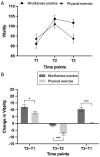Mindfulness Practice versus Physical Exercise in Enhancing Vitality
- PMID: 36767929
- PMCID: PMC9916355
- DOI: 10.3390/ijerph20032537
Mindfulness Practice versus Physical Exercise in Enhancing Vitality
Abstract
Vitality is important for subjective well-being and performance, which makes strategies for its enhancement an important research issue. While prior research showed that mindfulness practice and physical exercise are both effective at enhancing vitality, no study has compared their efficacy. This study aimed to address this issue. Seventy-one Chinese adults participated in the study and were randomized to one of the intervention groups, i.e., mindfulness practice or physical exercise. The mindfulness practice group completed guided mindfulness trainings, while the physical exercise group completed self-chosen aerobic trainings for seven days. The levels of vitality and its four factors at three time points (baseline, post-intervention, 7-day follow-up) were measured and compared. Compared with physical exercise, mindfulness practice showed stronger effects in enhancing vitality and maintaining the improvements. The findings suggest that guided mindfulness practice is more effective than self-chosen aerobic physical exercise at enhancing vitality and maintaining its improvements.
Keywords: energy; mindfulness; physical exercise; vitality.
Conflict of interest statement
The authors declare no conflict of interest.
Figures



Similar articles
-
Predictors of Mindfulness Meditation and Exercise Practice, from MEPARI-2, a randomized controlled trial.Mindfulness (N Y). 2019 Sep;10(9):1842-1854. doi: 10.1007/s12671-019-01137-3. Epub 2019 Mar 28. Mindfulness (N Y). 2019. PMID: 31938076 Free PMC article.
-
A pilot study of mindful walking training on physical activity and health outcomes among adults with inadequate activity.Complement Ther Med. 2019 Jun;44:116-122. doi: 10.1016/j.ctim.2019.03.009. Epub 2019 Mar 15. Complement Ther Med. 2019. PMID: 31126543
-
Effects of Mindfulness Training and Exercise on Cognitive Function in Older Adults: A Randomized Clinical Trial.JAMA. 2022 Dec 13;328(22):2218-2229. doi: 10.1001/jama.2022.21680. JAMA. 2022. PMID: 36511926 Free PMC article. Clinical Trial.
-
Special Issue - Therapeutic Benefits of Physical Activity for Mood: A Systematic Review on the Effects of Exercise Intensity, Duration, and Modality.J Psychol. 2019;153(1):102-125. doi: 10.1080/00223980.2018.1470487. Epub 2018 Oct 15. J Psychol. 2019. PMID: 30321106
-
Effects of Mindfulness Exercise Guided by a Smartphone App on Negative Emotions and Stress in Non-Clinical Populations: A Systematic Review and Meta-Analysis.Front Public Health. 2022 Jan 25;9:773296. doi: 10.3389/fpubh.2021.773296. eCollection 2021. Front Public Health. 2022. PMID: 35155341 Free PMC article.
Cited by
-
Individual vitality changes over 20 years among aging adults, using predefined and data-driven patterns: the Doetinchem Cohort Study.Eur J Ageing. 2025 Aug 11;22(1):42. doi: 10.1007/s10433-025-00878-6. Eur J Ageing. 2025. PMID: 40788379 Free PMC article.
-
Effectiveness of mobile mindfulness training on stress, burnout, and work engagement of office workers: protocol for a randomized controlled trial.Front Public Health. 2025 Jan 8;12:1440824. doi: 10.3389/fpubh.2024.1440824. eCollection 2024. Front Public Health. 2025. PMID: 39845675 Free PMC article.
-
Study Protocol for Mindfulness-Based Yoga Versus Physical Exercise on the Psychological Well-Being in Students With Early Visual Impairment: A Three-Armed, Multi-Centered, Randomized Controlled Trial.Cureus. 2024 Sep 12;16(9):e69240. doi: 10.7759/cureus.69240. eCollection 2024 Sep. Cureus. 2024. PMID: 39398856 Free PMC article.
References
-
- Ryan R.M., Deci E.L. From Ego Depletion to Vitality: Theory and Findings Concerning the Facilitation of Energy Available to the Self: From Ego Depletion to Vitality. Soc. Personal. Psychol. Compass. 2008;2:702–717. doi: 10.1111/j.1751-9004.2008.00098.x. - DOI
-
- Thayer R.E. The Origin of Everyday Moods: Managing Energy, Tension, and Stress. Oxford University Press; New York, NY, USA: 1996.
-
- Thayer R.E. Calm Energy: How People Regulate Mood with Food and Exercise. Oxford University Press; New York, NY, USA: 2001.
Publication types
MeSH terms
LinkOut - more resources
Full Text Sources
Medical

